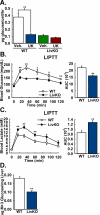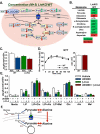Hepatic Mitochondrial Pyruvate Carrier 1 Is Required for Efficient Regulation of Gluconeogenesis and Whole-Body Glucose Homeostasis
- PMID: 26344103
- PMCID: PMC4754674
- DOI: 10.1016/j.cmet.2015.07.027
Hepatic Mitochondrial Pyruvate Carrier 1 Is Required for Efficient Regulation of Gluconeogenesis and Whole-Body Glucose Homeostasis
Abstract
Gluconeogenesis is critical for maintenance of euglycemia during fasting. Elevated gluconeogenesis during type 2 diabetes (T2D) contributes to chronic hyperglycemia. Pyruvate is a major gluconeogenic substrate and requires import into the mitochondrial matrix for channeling into gluconeogenesis. Here, we demonstrate that the mitochondrial pyruvate carrier (MPC) comprising the Mpc1 and Mpc2 proteins is required for efficient regulation of hepatic gluconeogenesis. Liver-specific deletion of Mpc1 abolished hepatic MPC activity and markedly decreased pyruvate-driven gluconeogenesis and TCA cycle flux. Loss of MPC activity induced adaptive utilization of glutamine and increased urea cycle activity. Diet-induced obesity increased hepatic MPC expression and activity. Constitutive Mpc1 deletion attenuated the development of hyperglycemia induced by a high-fat diet. Acute, virally mediated Mpc1 deletion after diet-induced obesity decreased hyperglycemia and improved glucose tolerance. We conclude that the MPC is required for efficient regulation of gluconeogenesis and that the MPC contributes to the elevated gluconeogenesis and hyperglycemia in T2D.
Copyright © 2015 Elsevier Inc. All rights reserved.
Figures






Comment in
-
Diabetes: Important role for MPC complex in hepatic gluconeogenesis.Nat Rev Endocrinol. 2015 Nov;11(11):629. doi: 10.1038/nrendo.2015.162. Epub 2015 Sep 22. Nat Rev Endocrinol. 2015. PMID: 26391977 No abstract available.
Similar articles
-
The mitochondrial pyruvate carrier mediates high fat diet-induced increases in hepatic TCA cycle capacity.Mol Metab. 2017 Nov;6(11):1468-1479. doi: 10.1016/j.molmet.2017.09.002. Epub 2017 Sep 18. Mol Metab. 2017. PMID: 29107293 Free PMC article.
-
Loss of Mitochondrial Pyruvate Carrier 2 in the Liver Leads to Defects in Gluconeogenesis and Compensation via Pyruvate-Alanine Cycling.Cell Metab. 2015 Oct 6;22(4):682-94. doi: 10.1016/j.cmet.2015.07.028. Epub 2015 Sep 3. Cell Metab. 2015. PMID: 26344101 Free PMC article.
-
Glucagon up-regulates hepatic mitochondrial pyruvate carrier 1 through cAMP-responsive element-binding protein; inhibition of hepatic gluconeogenesis by ginsenoside Rb1.Br J Pharmacol. 2019 Aug;176(16):2962-2976. doi: 10.1111/bph.14758. Epub 2019 Jul 6. Br J Pharmacol. 2019. PMID: 31166615 Free PMC article.
-
The mitochondrial pyruvate carrier in health and disease: To carry or not to carry?Biochim Biophys Acta. 2016 Oct;1863(10):2436-42. doi: 10.1016/j.bbamcr.2016.01.017. Epub 2016 Jan 26. Biochim Biophys Acta. 2016. PMID: 26826034 Review.
-
Mitochondrial pyruvate transport: a historical perspective and future research directions.Biochem J. 2015 Mar 15;466(3):443-54. doi: 10.1042/BJ20141171. Biochem J. 2015. PMID: 25748677 Free PMC article. Review.
Cited by
-
Mitochondrial pyruvate carrier function and cancer metabolism.Curr Opin Genet Dev. 2016 Jun;38:102-109. doi: 10.1016/j.gde.2016.05.003. Epub 2016 Jun 5. Curr Opin Genet Dev. 2016. PMID: 27269731 Free PMC article. Review.
-
Computational structural prediction and chemical inhibition of the human mitochondrial pyruvate carrier protein heterodimer complex.bioRxiv [Preprint]. 2024 Aug 10:2024.05.16.594520. doi: 10.1101/2024.05.16.594520. bioRxiv. 2024. PMID: 39071381 Free PMC article. Preprint.
-
Lysosomal cystine mobilization shapes the response of TORC1 and tissue growth to fasting.Science. 2022 Feb 18;375(6582):eabc4203. doi: 10.1126/science.abc4203. Epub 2022 Feb 18. Science. 2022. PMID: 35175796 Free PMC article.
-
The mitochondrial pyruvate carrier at the crossroads of intermediary metabolism.Am J Physiol Endocrinol Metab. 2022 Jul 1;323(1):E33-E52. doi: 10.1152/ajpendo.00074.2022. Epub 2022 May 30. Am J Physiol Endocrinol Metab. 2022. PMID: 35635330 Free PMC article. Review.
-
Effects of adding sodium dichloroacetate to low-protein diets on nitrogen balance and amino acid metabolism in the portal-drained viscera and liver of pigs.J Anim Sci Biotechnol. 2020 Apr 13;11:36. doi: 10.1186/s40104-020-00437-2. eCollection 2020. J Anim Sci Biotechnol. 2020. PMID: 32308979 Free PMC article.
References
-
- A J, Trygg J, Gullberg J, Johansson AI, Jonsson P, Antti H, Marklund SL, Moritz T. Extraction and GC/MS analysis of the human blood plasma metabolome. Anal Chem. 2005;77:8086–8094. - PubMed
-
- Brivet M, Garcia-Cazorla A, Lyonnet S, Dumez Y, Nassogne MC, Slama A, Boutron A, Touati G, Legrand A, Saudubray JM. Impaired mitochondrial pyruvate importation in a patient and a fetus at risk. Mol Genet Metab. 2003;78:186–192. - PubMed
Publication types
MeSH terms
Substances
Grants and funding
- R00 AR059190/AR/NIAMS NIH HHS/United States
- R24 DK096518/DK/NIDDK NIH HHS/United States
- R01 DK104998/DK/NIDDK NIH HHS/United States
- R01 DK078184/DK/NIDDK NIH HHS/United States
- T32 HL007638/HL/NHLBI NIH HHS/United States
- T32 HL007121/HL/NHLBI NIH HHS/United States
- P30 CA086862/CA/NCI NIH HHS/United States
- P01 DK058398/DK/NIDDK NIH HHS/United States
- P30CA086862/CA/NCI NIH HHS/United States
- T32 CA078586/CA/NCI NIH HHS/United States
- F32 DK101183/DK/NIDDK NIH HHS/United States
- T32 GM007337/GM/NIGMS NIH HHS/United States
- R01 GM094232/GM/NIGMS NIH HHS/United States
- GM007337/GM/NIGMS NIH HHS/United States
LinkOut - more resources
Full Text Sources
Other Literature Sources
Molecular Biology Databases

